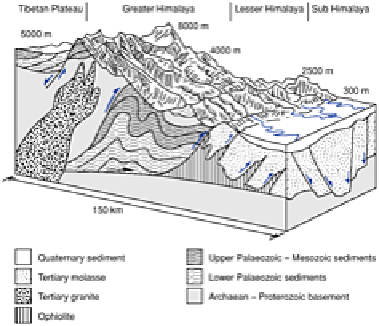Environmental Engineering Reference
In-Depth Information
Oceanic crust and sediments mark the collision boundary along the Indus-Tsangbo
suture, with the Tibetan plateau rising to the north (Figure 25.6). Indentation
accommodates head-on crustal shortening by expelling continental crust laterally, raising
other ranges subparallel to its path like a bow wave. The Hindu Kush to the west and
Hengduan Shan to the east are therefore parts of the indentation system, whereas interior
thrust and strike-slip forming the Kunlun Shan and Tien Shan ranges, north of Tibet, lie
ahead of it. The Himalayas and Karakoram ranges support many peaks over 7 km high
and several above 8 km, including Everest (8848 m), K2 Godwin Austen (8611 m),
Kangchenjunga (8586 m), Makalu (8475 m), Dhaulagiri (8172 m), Annapurna (8078 m)
and Gasherbrum (8068 m). Indentation rates of
Figure 25.6
Block section through the Himalayas.
Source: Modified from Vuichard, Institute of Mineralogy, University of
Berne.
2-5 cm a
−1
and tectonic uplift of 4 m ka
−1
ensure that the Himalayas are among Earth's
most geomorphically active areas. Evergreen forest grows at 2500 m on southern slopes
in annual average temperatures of 10° C but appears as fossils in Pliocene sediments
5900 m high and at -9° C in the northern Himalayas. This, and the occurrence of only the
latest Pleistocene glaciation in the Nan Shan range, is powerful evidence of the recent
rapid uplift of these mountains.
The Tethyan orogens, and especially the Himalayan ranges and Alps, lie along the
zonal climatic divisions of Asia and Europe. This accentuates meridional, north- south
thermal contrasts by limiting heat and moisture transfers, especially in Asia where the
Himalayas and Tibetan plateau inhibit northward penetration of the monsoon. Although
exerting less emphasis on global atmospheric circulation than American cordilleras, the
elevation and size of the Tibetan plateau profoundly disturb the Asian subtropical jet
stream, with major impacts on hemispherical climate. All ranges support alpine glaciation
and mountain ice caps (
Himalaya
is Sanskrit for 'land of snow and ice') and source some
of the largest rivers in Eurasia. Their relatively large human populations place them under
particular environmental stress.

